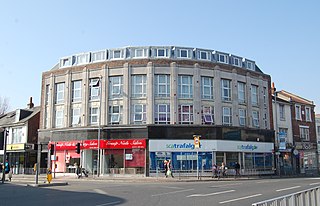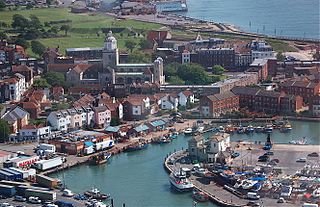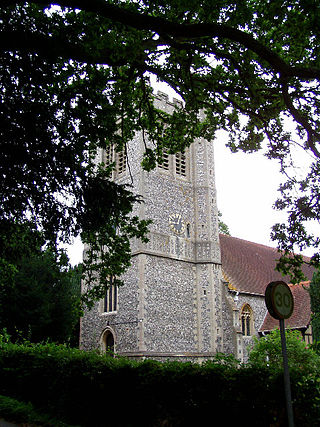
Havant is a town in the south-east corner of Hampshire, England,between Portsmouth and Chichester. Its borough comprises the town (45,826), the resort of Hayling Island, the town of Waterlooville, and the town of Emsworth. Housing and population more than doubled in the 20 years following World War II, a period of major conversion of land from agriculture and woodland to housing across the region following the incendiary bombing of Portsmouth and the Blitz.

Stamshaw is a residential district of Portsmouth, located on the north western corner of Portsea Island in southern England.

North End is a district in the city of Portsmouth, located on Portsea Island in Hampshire. The area developed rapidly as a part of the city after a horse-drawn tram route was opened between Portsmouth and Cosham. The area is mainly residential, being composed of mainly late Victorian to early 20th-century buildings.
Eastney is a district in the south-east corner of Portsmouth, England, on Portsea Island. Its electoral ward is called Eastney and Craneswater. At the 2011 Census the population of this ward was 13,591.

Finchdean is a rural hamlet in the East Hampshire district of Hampshire, England. It lies on the Hampshire/West Sussex border, 1.7 miles (2.7 km) east of Horndean.

Hilsea is a district of the city of Portsmouth in the English county of Hampshire. Hilsea is home to one of Portsmouth's main sports and leisure facilities – the Mountbatten centre. Trafalgar School is also in Hilsea. It is also the home of Portsmouth rugby football club
Kingston is a residential area of the city of Portsmouth in the English county of Hampshire, lying between Buckland, Fratton, Milton and North End. It was a recognised suburb of the city by the middle of the 19th century.

Rudmore is a district located on the western shore of Portsea Island and is part of the city of Portsmouth, England.

Landport is a district located on Portsea Island and is considered the city centre of modern-day Portsmouth, England. The district is centred around Commercial Road and encompasses the Guildhall, Civic Centre, Portsmouth and Southsea Station and Commercial Road central shopping area. The original historic old town of Portsmouth lies to the south of Landport and is now known as Old Portsmouth. The district of Portsea lies to the West; Somers Town and Southsea are to the south; Fratton lies to the East and the Kingston Crescent area to the north.

Old Portsmouth is a district of the city of Portsmouth. It is the area covered by the original medieval town of Portsmouth as planned by Jean de Gisors. It is situated in the south west corner of Portsea Island. The roads still largely follow their original layout.
East Tytherley is a small village in Hampshire, England.

Wellow is a village and civil parish in Hampshire, England that falls within the Test Valley district. The village lies just outside the New Forest, across the main A36 road which runs from the M27 motorway to Salisbury. The nearest town is Romsey, 4 miles (6.4 km) to the east, and the closest city is Southampton, 9 miles (14 km) to the southeast. The parish had a population of 3,239 in the 2021 census.

Mottisfont is a village and civil parish in the Test Valley district of Hampshire, England, around 4 miles (6.4 km) northwest of Romsey. The village is the location of Mottisfont Abbey. Much of the surrounding land, which is part of the Mottisfont Estate, and several other buildings in the village are in the care of the National Trust.

Durley is a village and civil parish in the City of Winchester district of Hampshire, England. It is located approximately 7½ miles (12.1 km) northeast of Southampton and has a population of around 992. The village is home to two pubs, The Robin Hood Inn and the Farmers Home. Both of the pubs have a rich history dating back till the nineteenth century. Durley is home to one school, Durley CE Primary. Which is home to approximately 130 pupils ranging from four to eleven years of age. The village also has one pre-school called Durley Ladybirds. The village is also home to a local church called the Church of the Holy Cross where services are regularly held.

Curdridge is a village and civil parish within the City of Winchester district of Hampshire, England. The parish also contains the similarly named village of Curbridge. The village has a small school. The parish is located eight miles to the east of Southampton and had a population of 1,292 people in 473 households in the 2001 census, the population increasing to 1,398 in 520 households at the 2011 Census. Curdridge is also known for its annual Curdridge Country Show that takes place in a field off Reading Room Lane

St Agatha's Church is a parish church in the Landport district of Portsmouth. It is now affiliated to the Roman Catholic Church through the Personal Ordinariate of Our Lady of Walsingham. It is situated on the Marketway next to the Cascades Shopping Centre. It was built between 1893 and 1895 for the Church of England and is a Grade II* listed building.
Buckland is a residential area in the city of Portsmouth in the English county of Hampshire.

Morestead is a village and former civil parish, now in the parish of Owslebury, in the Winchester district, in Hampshire, England. It is in the South Downs, about 3 miles (5 km) southeast of Winchester. In 1931 the parish had a population of 96. On 1 April 1932 the parish was abolished and merged with Owslebury.

Lee is a hamlet and civil parish in the Test Valley district of Hampshire, England. Its nearest town is Romsey, which lies approximately 3.7 miles (4.5 km) north from the hamlet. Lee is home to the Mountbatten Gallery previously Lee church built in 1862. The building's life as a gallery began in 1979. Across the road from the gallery are estate cottages designed by William Eden Nesfield dating from 1869.

The Mountbatten Centre is a leisure centre in Portsmouth, England, which opened in 1979, and was extended with a pool under a waveform roof in 2009. The "Mountbatten Centre" is located in Hilsea, an area in Portsmouth. The original design was by Ken Norrish the then city architect. The extension was designed by Saunders Architects.

















